Hoon Lee
On the Convergence of Large Language Model Optimizer for Black-Box Network Management
Jul 03, 2025Abstract:Future wireless networks are expected to incorporate diverse services that often lack general mathematical models. To address such black-box network management tasks, the large language model (LLM) optimizer framework, which leverages pretrained LLMs as optimization agents, has recently been promoted as a promising solution. This framework utilizes natural language prompts describing the given optimization problems along with past solutions generated by LLMs themselves. As a result, LLMs can obtain efficient solutions autonomously without knowing the mathematical models of the objective functions. Although the viability of the LLM optimizer (LLMO) framework has been studied in various black-box scenarios, it has so far been limited to numerical simulations. For the first time, this paper establishes a theoretical foundation for the LLMO framework. With careful investigations of LLM inference steps, we can interpret the LLMO procedure as a finite-state Markov chain, and prove the convergence of the framework. Our results are extended to a more advanced multiple LLM architecture, where the impact of multiple LLMs is rigorously verified in terms of the convergence rate. Comprehensive numerical simulations validate our theoretical results and provide a deeper understanding of the underlying mechanisms of the LLMO framework.
Large-Scale AI in Telecom: Charting the Roadmap for Innovation, Scalability, and Enhanced Digital Experiences
Mar 06, 2025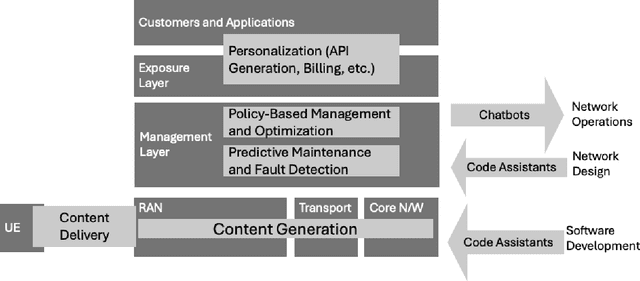
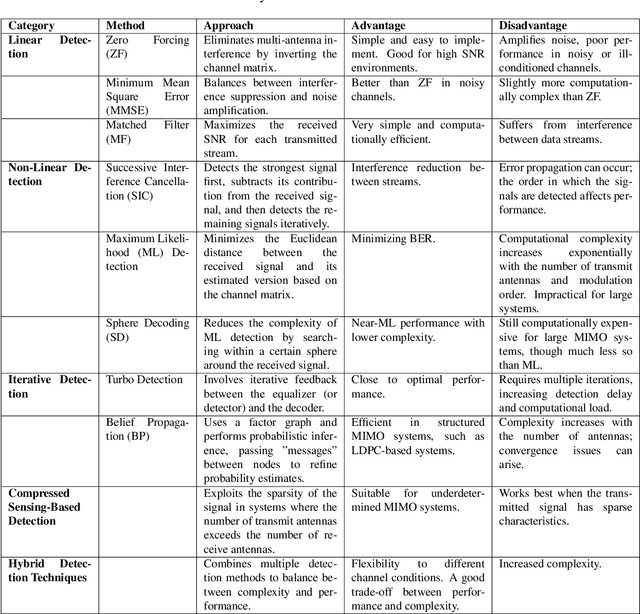
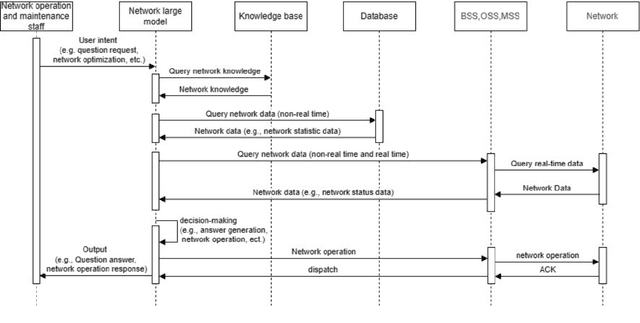
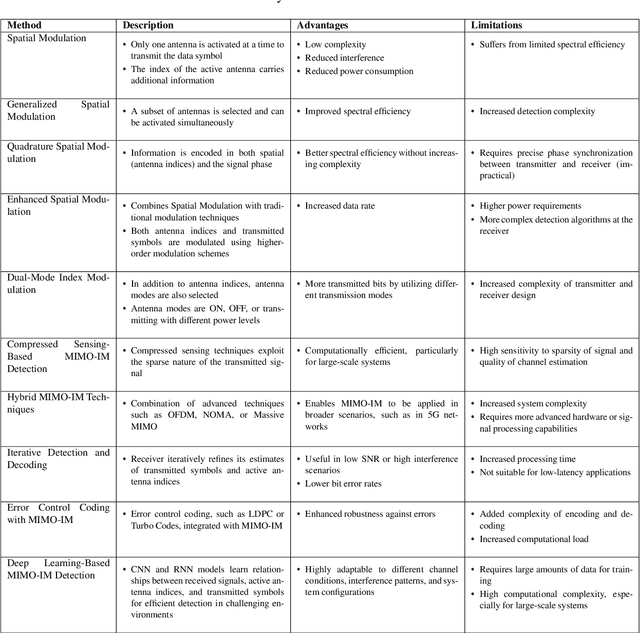
Abstract:This white paper discusses the role of large-scale AI in the telecommunications industry, with a specific focus on the potential of generative AI to revolutionize network functions and user experiences, especially in the context of 6G systems. It highlights the development and deployment of Large Telecom Models (LTMs), which are tailored AI models designed to address the complex challenges faced by modern telecom networks. The paper covers a wide range of topics, from the architecture and deployment strategies of LTMs to their applications in network management, resource allocation, and optimization. It also explores the regulatory, ethical, and standardization considerations for LTMs, offering insights into their future integration into telecom infrastructure. The goal is to provide a comprehensive roadmap for the adoption of LTMs to enhance scalability, performance, and user-centric innovation in telecom networks.
Sequential In-Network Processing for Cell-Free Massive MIMO with Capacity-Constrained Parallel Radio Stripes
Dec 10, 2024Abstract:To ensure coherent signal processing across distributed Access Points (APs) in Cell-Free Massive Multiple-Input Multiple-Output (CF-mMIMO) systems, a fronthaul connection between the APs and a Central Processor (CP) is imperative. We consider a fronthaul network employing parallel radio stripes. In this system, APs are grouped into multiple segments where APs within each segment are sequentially connected through a radio stripe. This fronthaul topology strikes a balance between standard star and bus topologies, which deploy parallel or serial connections of all APs. Our focus lies in designing the uplink signal processing for a CF-mMIMO system with parallel radio stripes. We tackle the challenge of finite-capacity fronthaul links by addressing the design of In-Network Processing (INP) strategies at APs. These strategies involve linearly combining received signals and compressing the combining output for fronthaul transmission, aiming to maximize the sum-rate performance. Given the high complexity and the stringent requirement for global Channel State Information (CSI) in jointly optimizing INP strategies across all APs, we propose an efficient sequential design approach. Numerical results demonstrate that the proposed sequential INP design achieves a sum-rate gain of up to 82.92% compared to baseline schemes.
Generalized Reduced-WMMSE Approach for Cell-Free Massive MIMO With Per-AP Power Constraints
Aug 02, 2024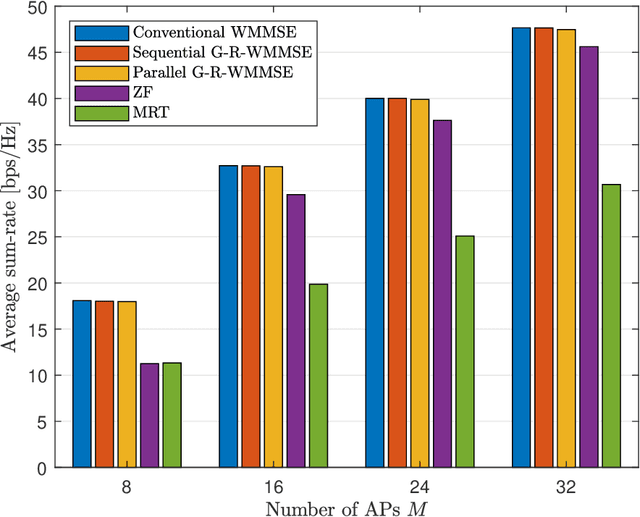
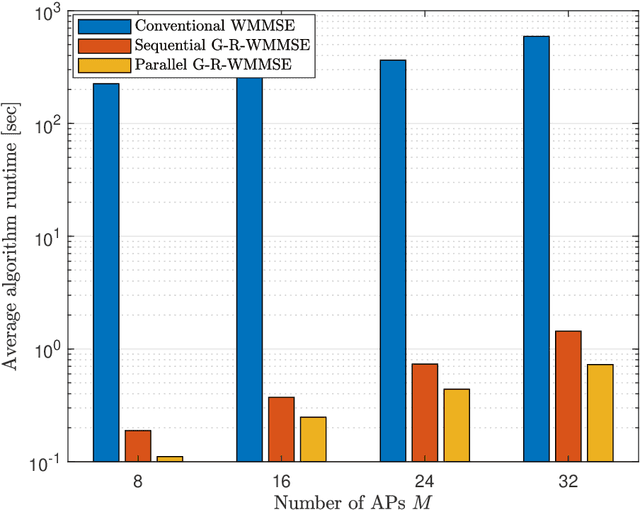
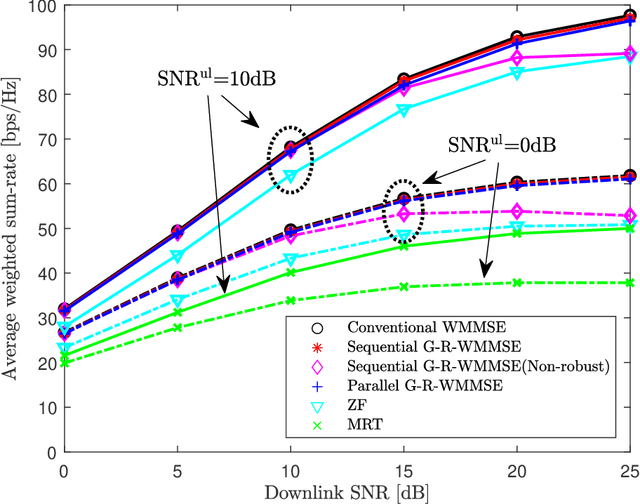
Abstract:The optimization of cooperative beamforming vectors in cell-free massive MIMO (mMIMO) systems is presented where multi-antenna access points (APs) support downlink data transmission of multiple users. Albeit the successes of the weighted minimum mean squared error (WMMSE) algorithm and their variants, they lack careful investigations about computational complexity that scales with the number of antennas and APs. We propose a generalized and reduced WMMSE (G-R-WMMSE) approach whose complexity is significantly lower than conventional WMMSE. We partition the set of beamforming coefficients into subvectors, with each subvector corresponding to a specific AP. Such a partitioning approach decomposes the original WMMSE problem across individual APs. By leveraging the Lagrange duality analysis, a closed-form solution can be derived for each subproblem, which substantially reduces the computation burden. Additionally, we present a parallel execution of the proposed G-R-WMMSE with adaptive step sizes, aiming at further reducing the time complexity. Numerical results validate that the proposed G-R-WMMSE schemes achieve over 99% complexity savings compared to the conventional WMMSE scheme while maintaining almost the same performance.
Machine Learning-Aided Cooperative Localization under Dense Urban Environment
Apr 05, 2024Abstract:Future wireless network technology provides automobiles with the connectivity feature to consolidate the concept of vehicular networks that collaborate on conducting cooperative driving tasks. The full potential of connected vehicles, which promises road safety and quality driving experience, can be leveraged if machine learning models guarantee the robustness in performing core functions including localization and controls. Location awareness, in particular, lends itself to the deployment of location-specific services and the improvement of the operation performance. The localization entails direct communication to the network infrastructure, and the resulting centralized positioning solutions readily become intractable as the network scales up. As an alternative to the centralized solutions, this article addresses decentralized principle of vehicular localization reinforced by machine learning techniques in dense urban environments with frequent inaccessibility to reliable measurement. As such, the collaboration of multiple vehicles enhances the positioning performance of machine learning approaches. A virtual testbed is developed to validate this machine learning model for real-map vehicular networks. Numerical results demonstrate universal feasibility of cooperative localization, in particular, for dense urban area configurations.
Task-Oriented Edge Networks: Decentralized Learning Over Wireless Fronthaul
Dec 03, 2023



Abstract:This paper studies task-oriented edge networks where multiple edge internet-of-things nodes execute machine learning tasks with the help of powerful deep neural networks (DNNs) at a network cloud. Separate edge nodes (ENs) result in a partially observable system where they can only get partitioned features of the global network states. These local observations need to be forwarded to the cloud via resource-constrained wireless fronthual links. Individual ENs compress their local observations into uplink fronthaul messages using task-oriented encoder DNNs. Then, the cloud carries out a remote inference task by leveraging received signals. Such a distributed topology requests a decentralized training and decentralized execution (DTDE) learning framework for designing edge-cloud cooperative inference rules and their decentralized training strategies. First, we develop fronthaul-cooperative DNN architecture along with proper uplink coordination protocols suitable for wireless fronthaul interconnection. Inspired by the nomographic function, an efficient cloud inference model becomes an integration of a number of shallow DNNs. This modulized architecture brings versatile calculations that are independent of the number of ENs. Next, we present a decentralized training algorithm of separate edge-cloud DNNs over downlink wireless fronthaul channels. An appropriate downlink coordination protocol is proposed, which backpropagates gradient vectors wirelessly from the cloud to the ENs.
Joint Precoding and Fronthaul Compression for Cell-Free MIMO Downlink With Radio Stripes
Aug 07, 2023



Abstract:A sequential fronthaul network, referred to as radio stripes, is a promising fronthaul topology of cell-free MIMO systems. In this setup, a single cable suffices to connect access points (APs) to a central processor (CP). Thus, radio stripes are more effective than conventional star fronthaul topology which requires dedicated cables for each of APs. Most of works on radio stripes focused on the uplink communication or downlink energy transfer. This work tackles the design of the downlink data transmission for the first time. The CP sends compressed information of linearly precoded signals to the APs on fronthaul. Due to the serial transfer on radio stripes, each AP has an access to all the compressed blocks which pass through it. Thus, an advanced compression technique, called Wyner-Ziv (WZ) compression, can be applied in which each AP decompresses all the received blocks to exploit them for the reconstruction of its desired precoded signal as side information. The problem of maximizing the sum-rate is tackled under the standard point-to-point (P2P) and WZ compression strategies. Numerical results validate the performance gains of the proposed scheme.
Rate-Splitting Multiple Access for 6G Networks: Ten Promising Scenarios and Applications
Jun 22, 2023Abstract:In the upcoming 6G era, multiple access (MA) will play an essential role in achieving high throughput performances required in a wide range of wireless applications. Since MA and interference management are closely related issues, the conventional MA techniques are limited in that they cannot provide near-optimal performance in universal interference regimes. Recently, rate-splitting multiple access (RSMA) has been gaining much attention. RSMA splits an individual message into two parts: a common part, decodable by every user, and a private part, decodable only by the intended user. Each user first decodes the common message and then decodes its private message by applying successive interference cancellation (SIC). By doing so, RSMA not only embraces the existing MA techniques as special cases but also provides significant performance gains by efficiently mitigating inter-user interference in a broad range of interference regimes. In this article, we first present the theoretical foundation of RSMA. Subsequently, we put forth four key benefits of RSMA: spectral efficiency, robustness, scalability, and flexibility. Upon this, we describe how RSMA can enable ten promising scenarios and applications along with future research directions to pave the way for 6G.
Learning Decentralized Power Control in Cell-Free Massive MIMO Networks
Mar 05, 2023Abstract:This paper studies learning-based decentralized power control methods for cell-free massive multiple-input multiple-output (MIMO) systems where a central processor (CP) controls access points (APs) through fronthaul coordination. To determine the transmission policy of distributed APs, it is essential to develop a network-wide collaborative optimization mechanism. To address this challenge, we design a cooperative learning (CL) framework which manages computation and coordination strategies of the CP and APs using dedicated deep neural network (DNN) modules. To build a versatile learning structure, the proposed CL is carefully designed such that its forward pass calculations are independent of the number of APs. To this end, we adopt a parameter reuse concept which installs an identical DNN module at all APs. Consequently, the proposed CL trained at a particular configuration can be readily applied to arbitrary AP populations. Numerical results validate the advantages of the proposed CL over conventional non-cooperative approaches.
Deep Learning for Multi-User MIMO Systems: Joint Design of Pilot, Limited Feedback, and Precoding
Sep 21, 2022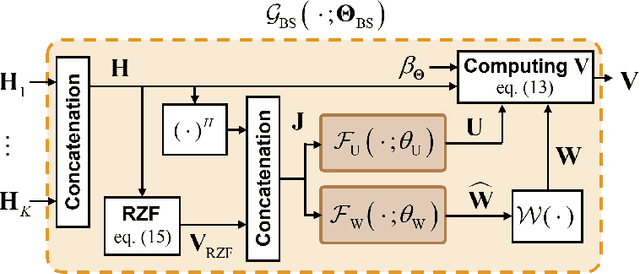
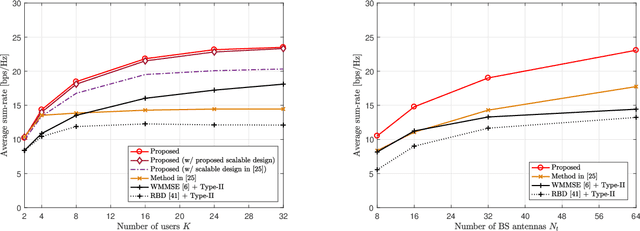
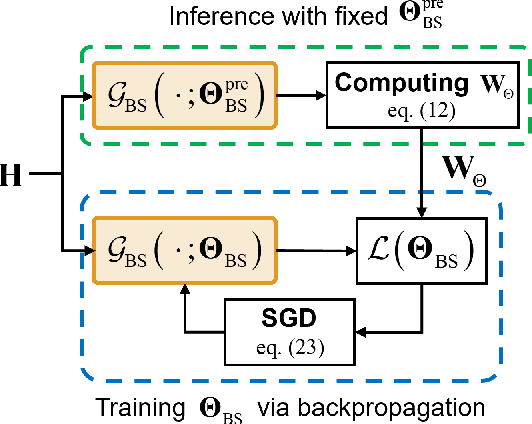
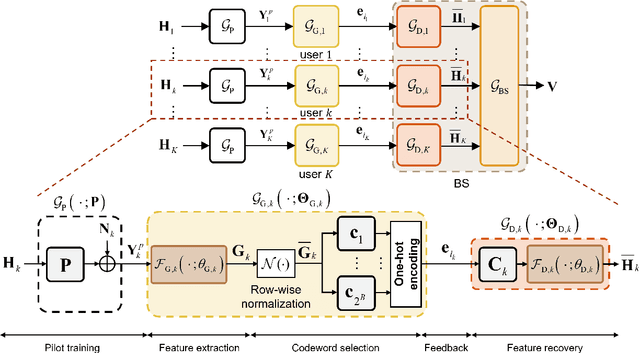
Abstract:In conventional multi-user multiple-input multiple-output (MU-MIMO) systems with frequency division duplexing (FDD), channel acquisition and precoder optimization processes have been designed separately although they are highly coupled. This paper studies an end-to-end design of downlink MU-MIMO systems which include pilot sequences, limited feedback, and precoding. To address this problem, we propose a novel deep learning (DL) framework which jointly optimizes the feedback information generation at users and the precoder design at a base station (BS). Each procedure in the MU-MIMO systems is replaced by intelligently designed multiple deep neural networks (DNN) units. At the BS, a neural network generates pilot sequences and helps the users obtain accurate channel state information. At each user, the channel feedback operation is carried out in a distributed manner by an individual user DNN. Then, another BS DNN collects feedback information from the users and determines the MIMO precoding matrices. A joint training algorithm is proposed to optimize all DNN units in an end-to-end manner. In addition, a training strategy which can avoid retraining for different network sizes for a scalable design is proposed. Numerical results demonstrate the effectiveness of the proposed DL framework compared to classical optimization techniques and other conventional DNN schemes.
 Add to Chrome
Add to Chrome Add to Firefox
Add to Firefox Add to Edge
Add to Edge